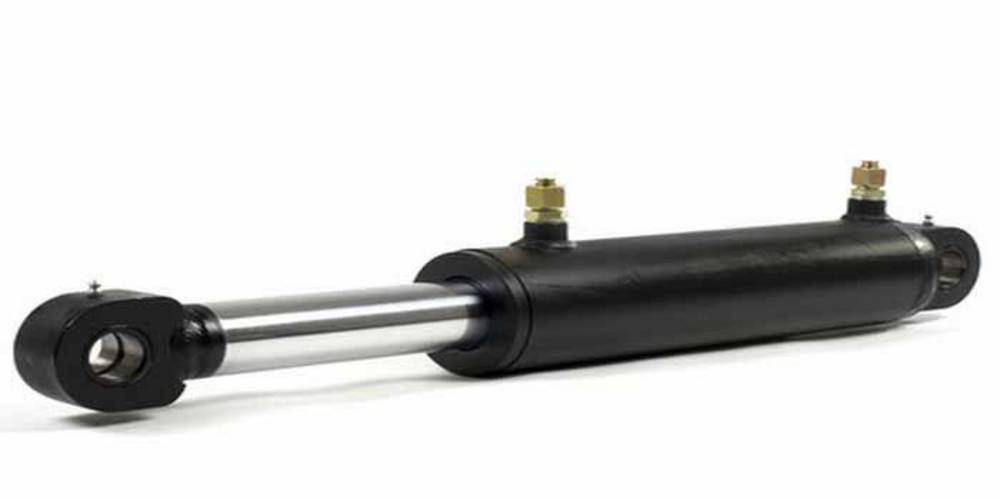The first article in our series on Lift table types and their advantages and disadvantages deals with the hydraulic lift table.
How it works
A hydraulic scissor lift table is powered by an electric motor. A hydraulic pump is flange-mounted on the motor, which pumps the pressure medium into the lifting cylinders. As the cylinders are connected to the two scissor sections of the lift table, the platform and the load on it are raised when the cylinders are extended.
The downward movement of the platform is achieved by retracting the cylinders. Because hydraulic scissor lifts mostly have a very solid structure, the dead weight of the lift table is usually sufficient for this purpose. Double-acting hydraulic cylinders may have to be used for a lightweight lift table.
Advantages of the hydraulic scissor lift
Compared to other lift table designs, the hydraulic scissor lift table has a number of advantages:
Retrospective reduction of the lifting times
It is sometimes necessary to retrospectively reduce the lifting or lowering time of a lift table. An example is the optimisation of cycle times in production.
As many lift table manufacturers build scissor lift tables which are mechanically oversized, there are often reserves in the lifting and lowering times for which they are designed. A reduction can already be achieved by replacing the hydraulic pump with one with a higher volume flow.
Less wear
The wear on hydraulic drives is less than on other mechanical lift table drives. This is due to the principle of transmission of force. In contrast to the other lift table types, mechanical friction is not responsible for the transmission of force, but by the build-up of pressure in the cylinders.
The fluid used for pressure transmission also contributes to the lubrication of the mechanical components, so that the friction between the solid parts is massively reduced. At the same time, the pressure fluid acts as a cooling medium in the hydraulic circuit.
Discretionary placement of the drive unit
One positive aspect of pressure transmission by means of a fluid is the spatial separation of the power unit from the place where the force is developed. It is also possible to place the power unit outside the working area without any problems. The necessary hoses and pipes can almost be laid at will.
Simple and reliable overload protection
In a hydraulic power unit, the maximum permissible load can easily be adjusted by means of a pressure relief valve. This ensures that the maximum permissible pressure in the hydraulic system is maintained by a simple mechanism. This important safety function is therefore not dependent on error-prone electronics.
One power unit for linear and circular movements
One of the most requested additional equipment for lifting tables is the rotating platform. In contrast to lifting cylinders, the rotary drive is not required to perform linear motion but circular motion.
Spindle lift tables need an additional drive unit for this purpose, as the lifting spindle cannot simply be used for the rotating movement. Hydraulic lifting tables, on the other hand, have the advantage that the same power unit can drive both linear and circular movements through appropriate pickups.
Inexpensive
Hydraulic lifting tables use components that are also used in other industries. This includes cylinders, pumps, valve blocks or valves, to mention a few. These components are also produced in large quantities for other sectors of industry. The advantages of cost degression can therefore also be used in one-off or small series production.
A rule of thumb is that an electro-hydraulic lift table costs about half of a comparable belt-drive or spindle lift table.
Energy only required during the lifting movement
It was already mentioned in the functional description that the dead weight of the lift table is usually sufficient to lower the platform. Despite the comparatively low efficiency of the motor-pump combination, this provides a good energy balance for the hydraulic lifting table.
Disadvantages of hydraulic scissor lifts
Even though the hydraulically operated lift table has a number of advantages, the existing disadvantages should not be overlooked:
Use in food sector
In the past, the use of a hydraulic lift in the food sector posed a problem. This disadvantage has now been eliminated through the use of food-grade pressure media.
Low positioning accuracy
If a high positioning accuracy of the lift table is required at many different landings, this is not easily achieved with a hydraulic lift table.
Locking bolts or supports are usually offered in the market as a solution. Locking bolts, however, require a corresponding holding fixture in the counterpart. This is not a problem if the lift table is installed in a shaft and the landings are far enough apart. However, locking bolts cannot be used if the lift table is used as a free-standing unit or if very small distances between landings are required.
Supports, in turn, are only suitable for a few landings. In most cases, hydraulically collapsible supports are used on which the platform of the lift table can be set down. This is still practical for a limited number of landings. Other solutions must be found for a larger number of landings, though.
In addition, the use of electrical sensors is necessary for hydraulic lift tables. Inductive sensors or cable length sensors would be conceivable, for example.
In this case, inductive sensors are combined with a catch-up control. If the signal from the sensor drops out, the control system turns the drive unit on until the platform is back in the sensor's range.
Cable length sensors can determine the position of a lift table very precisely. Any number of positions can be precisely approached using an appropriate electrical control system. The current position of the lift table is continuously monitored after it has been reached and any deviation is compensated for by the power unit or the lowering valve.
Heating of the hydraulic oil
There is a risk that the hydraulic oil may heat up to unacceptably high temperatures at very high cycle rates. The problem here is that the hydraulic pump is subjected to increased wear due to the higher temperatures and this can lead to premature component failure. There is also a risk that the hydraulic oil starts to foam. This could cause air to enter the circuit. In contrast to hydraulic oil, air can be compressed much more, which could cause unexpected platform movement.
There are two ways to deal with this problem:
- Increase the oil quantity.
- Install special cooling systems.
In the first solution, the volume of the hydraulic tank is increased. This means that more oil is available for heat absorption. This is to prevent an unacceptable temperature increase.
Oil coolers can also be used if a lack of space does not allow volume to be increased. They dissipate the heat to the environment and limit the temperature rise to an acceptable level.
Temperature of hydraulic oil too low
The viscosity of the hydraulic oil used changes when the lift table is used at extremely low ambient temperatures. The oil becomes more viscous and can only be pumped with difficulty or not at all, i.e. the lift table is no longer functional.
A heater can be installed in the tank for such applications. If the temperature is too low, it can be switched on to restore the lift table's functionality.
Noise emission
There is always some noise emission associated with the use of the hydraulic power unit. In most cases, this is not a problem, as the lift table is either used in an industrial environment with a corresponding background noise level or the power unit is placed in a special room.
In all other cases, the power unit must be insulated. In many technical sectors, for example, automotive engineering, the insulation of the drive unit has already become standard practice.
Compression and rebound of the lift table
Without additional technical measures, a hydraulic lift table compresses and rebounds in the raised position when the load is transferred.
This is due to the compression of the hydraulic oil in the cylinders. The additional application of a load when the lift table is in the raised position increases the pressure in the cylinders. The increase in pressure causes the piston rod of the hydraulic cylinder to retract minimally and the lift table to deflect. When the lift table is unloaded in the raised position, the pressure in the cylinders is reduced and the piston rod extends minimally. The extent of the compression or rebound depends on the pressure difference and so also on the additional load being applied or removed. The lower the load in relation to the lift table's dead weight, the smaller the spring deflection.
Filtering of the hydraulic oil
Wipers are used in hydraulic cylinders to protect the hydraulic circuit and prevent contaminants such as dirt and moisture from entering the hydraulic system. However, these do not work perfectly and particularly rough operating conditions would lead to an increase in mechanical wear of the installed components when additional measures are not introduced.
Apart from these external influences, mechanical abrasion inside the circuit also generates undesirable foreign particles in the hydraulic oil. Undesirable contaminants in the oil increases the wear of the hydraulic pump and the cylinders. For this reason, many lift table manufacturers use filters as standard to remove these particles and increase the service life of the components.
Risk of leaks
Leaks are unfortunately a risk when using a hydraulic lift table. This can have various causes. The following can be given as examples:
- Laying the hydraulic hoses over sharp edges
- Using the hydraulic hoses in the wrong temperature range
- Mechanical damage to the hydraulic lines
- ...
The risk of leaks can be greatly reduced by laying the hydraulic lines properly and professionally, but unfortunately it cannot be completely prevented. Due to material defects or similar defects in the hydraulic circuit, leaks cannot be completely excluded.
Unlike the wires of an underfloor heating system, hydraulic lines should therefore never be solidly cast in the floor screed or concrete. The supply line of a hydraulic lift table should always be laid in such a way that subsequent access is possible. Conduits in the concrete, for example, are suitable for this purpose.



Comments (0)
No comments found!